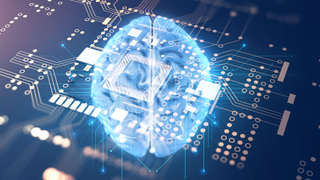Water-Based Chips Could be Breakthrough for Neural Networking, AI
Wetware has gains an entirely new meaning

Scientists are following nature's own designs in developing ionic microprocessors, which could prove particularly energy-efficient compared with traditional semiconductor-based processors.
As published in Advanced Materials, a team of researchers with Harvard's John A. Paulson School of Engineering and Applied Sciences (SEAS), in collaboration with biotech startup DNA Script, have developed an ionic circuit comprising hundreds of ionic transistors. They have even performed a core process of neural net computing within it — wetware is becoming less and less of a sci-fi buzz word.
Ionic processor design aims to bring learnings from biology's processing systems — particularly brains — to create processors that make use of electrochemistry instead of electricity to perform calculations. Research paints ionic processors as a likely technology to be developed and scaled towards the future, where their energy-efficient designs could be valuable for certain deployment scenarios.
It's still early for the technology, as the researchers have just mounted the first circuit board that actually contained hundreds of ionic transistors — up to now, only single ionic transistors had been show. The research thus paves the way for the actual processors to be created by operating hundreds — thousands, or even millions — of ionic transistors in tandem.
The researcher's ionic circuit was created from multiplying the number of single ionic transistors that can operate together. Their ionic transistor design consists of an aqueous solution of quinone molecules, interfaced with two concentric ring electrodes (blue and red) with a third (yellow), center disk electrode, essentially forming a bullseye-like transistor design.

By running voltage through the transistor, the two concentric ring electrodes are able to locally tune the water's pH by increasing or lowering the amount of hydrogen ions present in it. This change, a feat of electrochemistry, allows for the usage of the transistor's ionic current as an on and off switch — known as gate, in the transistors we're used to hearing about. This gating of the ionic current through changes in the transistor's pH unlocks the ability for the transistors to process binary information.
The researchers further tuned their microprocessor design, placing these analogue transistors (capable of representing a 0 or a 1) into a 16 x 16 matrix grid array. This allowed the ionic processor to perform matrix multiplication tasks, bringing it closer to a neural network's capabilities and increasing its value for artificial intelligence processing scenarios that might require very specific performance/power balance requirements.
Stay on the Cutting Edge
Join the experts who read Tom's Hardware for the inside track on enthusiast PC tech news — and have for over 25 years. We'll send breaking news and in-depth reviews of CPUs, GPUs, AI, maker hardware and more straight to your inbox.
“Matrix multiplication is the most prevalent calculation in neural networks for artificial intelligence,” said Woo-Bin Jung, a postdoctoral fellow at SEAS and the first author of the paper. “Our ionic circuit performs the matrix multiplication in water in an analog manner that is based fully on electrochemical machinery.”
The trade-off is that they're slower — but compared to light, everything is. The researchers now hope to keep developing their ionic processors by allowing them to leverage a higher number of electrochemical reactions, such as increasing the types of ions that are manipulated to process information. The researchers can still be looking forward to program additional functions in these systems.
That, paired with the increase in the number of available transistors, should provide for performance benefits while opening up ionic processors to more varied tasks and actual specific or general-purpose computing.
“So far, we have used only 3 to 4 ionic species, such as hydrogen and quinone ions, to enable the gating and ionic transport in the aqueous ionic transistor,” said Jung. “It will be very interesting to employ more diverse ionic species and to see how we can exploit them to make rich the contents of information to be processed.”

Francisco Pires is a freelance news writer for Tom's Hardware with a soft side for quantum computing.
-
Rob1C The link to the Advanced Materials site in the article here requires an account to read the paper, this link does not: https://www.researchgate.net/publication/362891571_Aqueous_analog_MAC_machineReply -
bit_user @Francisco Alexandre Pires , thanks for the writeup!Reply
But...
Ionic processor design aims to bring learnings lessons learned from biology's processing systems
FTFY. Please don't perpetuate this abuse of the English language.
The researchers further tuned their microprocessor design, placing these analogue transistors (capable of representing a 0 or a 1) into a 16 x 16 matrix grid array. This allowed the ionic processor to perform matrix multiplication tasks,
I don't see how individual transistors would enable digital matrix multiplication. I suspect they're actually multiplying them in the analog domain. Analog computing is also much more power-efficient, though it tends to be inherently noisy.
Ah, and the subsequent quote confirms this:
“Our ionic circuit performs the matrix multiplication in water in an analog manner that is based fully on electrochemical machinery.”
Lastly,
“It will be very interesting to employ more diverse ionic species and to see how we can exploit them to make rich the contents of information to be processed.”
Implies they're either contemplating non-base2 arithmetic, or perhaps there's some way they can use different ions to enable vector processing?
Most Popular




